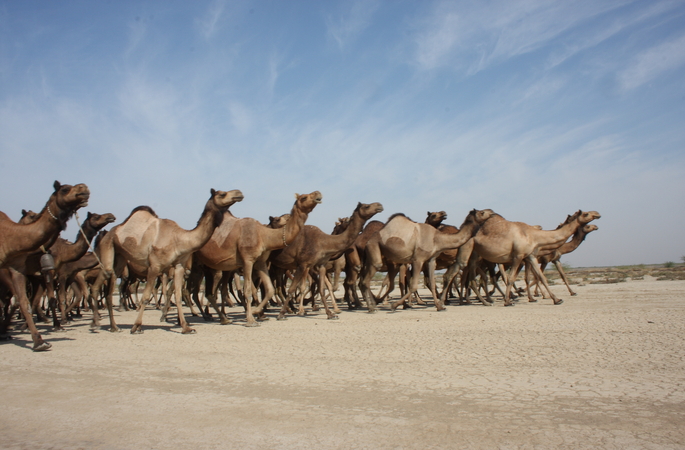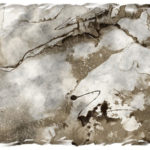Like this, like that
Like Here, like there
Friend, enemy
Life, death
All the same
All is he…
– Shah Abdul Latif (1689-1752)
For millennia, movement has been central to the existence of human communities across the world. The nomad’s logic always defied the logic of the settlers. A choolah (hearth) that is grounded, a grinding stone that is fixed, water from a well- all these were all taboos for many nomadic communities in the Indian subcontinent. The freedom to move that was crucial to the survival of communities involved in hunting, food gathering, pastoralism and shifting cultivation has been severely curtailed as settled modes of existence have become the norm, as national boundaries have hardened and state policies have delegitimised nomadic ways of living. The mobility of these populations was regarded as a threat by the colonial administration, which tried to discipline them, through punitive measures. Post-independence, the disciplinary project of the state remains unchanged; this, combined with the triumphant march of liberalization and globalisation, has further marginalised these communities.
Kachchh in Gujarat has traditionally been home to several pastoral or Maldhari communities that were itinerant. This piece is based on our film-making practice with the Fakirani Jatts and the Meghwals. The Jatts are Muslim pastoralists who are related in distant history to the Jats of Punjab. The Meghwals are a Dalit (formerly untouchable) community, mainly pastoral; they identify themselves as Hindu. Kachchh can be divided into distinct areas: in the North and East are the marshy salt flats of the Great Rann of Kachchh and the Little Rann. Moving southwards, one comes across the extensive grasslands of Banni; then the plains and hills of the mainland and finally the coastal mangrove stretch.
The pastoralists are to be found mainly in the Banni area. These communities lived traditionally in semi-settled hamlets and moved seasonally with their cattle in search of pastures and for trade in milk products. In earlier times, they would go to Sindh (now in Pakistan) in the North, across the salt flats of the Great Rann of Kachchh for trade and in search of pastures. For drought prone Kachchh, Sindh was like a safety net. When the grasslands of Banni were parched and dry, many communities would pack up their belongings and make the long trek across the blistering Rann to the greener pastures of Sindh.
The movement was in both directions, with pastoral communities, both ‘Hindu’ and ‘Muslim’ in Sindh and the desert district of Tharparkar maintaining relationships based on trade and marriage with their counterparts in Kachchh. In earlier times, these religious identities were not foregrounded and many of these groups were ‘tribals’ with their own beliefs and practices and were hence regarded to be of ‘indeterminate’ religion. The identification with one or the other religion came later, particularly with the Partition.
The Partition of India and Pakistan, perhaps the most traumatic event in the living memory of the subcontinent, transformed the lives of these communities forever. The border became the fault-line for divides which hitherto never existed. The pastoralists and their families, who moved between regions in search of fodder and water, found themselves trapped in recently imagined nations. In the words of Haji Umar, a Fakirani Jatt pastoralist from Abdasa, Kachchh:
My mother would say that in the year I was born… in that year, though people could come and go, but India and Pakistan were partitioned. It’s been about 20 years since the border is closed completely. Previously, people would come and go stealthily…Brother here, sister there, father there, son here. Children orphaned here, mother stranded there. This is still the case. But how this injustice took place, God alone knows!
After the Partition, the border was somewhat porous until the Indo-Pak conflict of 1965, after which official contacts ceased and the Rann became a militarised zone under surveillance. In prisons on both sides of the border languish many pastoralists and fishermen who have strayed into the space of the ‘other’, either by mistake or by design. In our conversations, many of the older generation expressed a longing to meet their relatives in Sindh.
The emergence of hard borders is not the only threat to the semi-nomadic pastoralism of the Maldharis. The state has been to a large measure responsible for the destruction of these ways of living, through its environmental policies, its promotion of industrialisation and its deep-seated suspicion and contempt of these communities.
In 1877, the British introduced Prosopis juliflora, an exotic acacia species, to India. In the 1950s and 60s this tree was propagated by the Forest Department in Kachchh as a part of its anti-desertification programme and became an ecological disaster, taking over the grasslands, irreversibly changing the lives of communities in the region. Its spread has adversely affected the growth of grass and depleted the water table in the area. It cannot be used as fodder as it is toxic to most of the livestock.
Today, the Jatts and other Maldharis in the Banni are caught between the myopic policies of the Forest Department and the rapid industrialisation of the area informed by visions of ‘development’. They have no rights to their grazing lands and bear the double burden of being pastoralist and Muslim. Living close to the border in a state ruled by a right-wing Hindu party, their citizenship rights are rendered somewhat tenuous and their allegiance to the nation-state suspect. The marginalisation of all Maldharis is economic, social as well as cultural: the language that their children learn in school is neither Kachchhi nor Sindhi, which are among the spoken languages, but Gujarati. There is little space for the survival of these languages and cultural traditions, except as marketable tourist exotica.
The entire region of Sindh and Kachchh share common cultural traditions, drawing on Sufism and other open-ended practices that have created a rich repertoire of poetry, folklore, embroidery, and visual culture. Shah Abdul Latif Bhitai, a medieval Sufi poet, is an iconic figure in the cultural history of Sindh. Bhitai’s Shah Jo Risalo is a remarkable collection of poems sung by many communities in Kachchh and Sindh, which draw on the eternal love stories of Umar-Marui and Sasui-Punhu, among others. These songs speak of the pain of parting, of the inevitability of loss and of deep grief that takes one to unknown and mysterious terrains.
Shah Bhitai’s poems have a deep resonance with the lifeworlds of the Maldharis, a space of transience, flux, finitude and a respect for the other. This philosophical sub-text is eloquently articulated by Haji Umar, a pastoralist and self-taught Sufi scholar:
When souls were created, they were just souls. Not Hindus or Muslims or Christians or Sikhs. Just souls. That’s from where Bhitai starts his journey […] Today the world has forgotten Bhitai’s “Like Here, like there”. But if we understand the true meaning of his verses, we will realise that whether we are Americans or Japanese or Indians or Pakistanis, we are all children of Adam. And I am not as good as the other. The other is better than me.
This is a profound insight into the worldview of many Maldhari communities, that recognise difference and yet do not perceive it as threatening. Today, this ability to live with difference and uncertainty is changing. Yet, more than before, this marginalised wisdom needs to be affirmed in a world that promotes tourism and transnational capital but seeks to discipline and control transhumance; a world that privileges borders and fixed identities; that museumises diversity while normalising the ethnocide of nomadic cultures and ways of living.
Note: This piece is based on the authors’ trilogy of films on Sufi musical traditions in Kachchh. A longer version entitled Like Here Like There appeared in Himal South Asian, October 2011.



